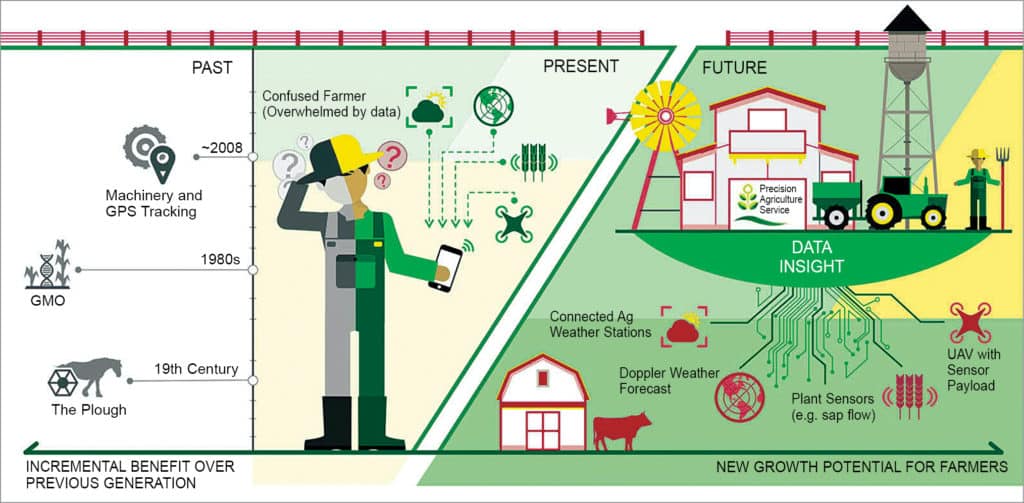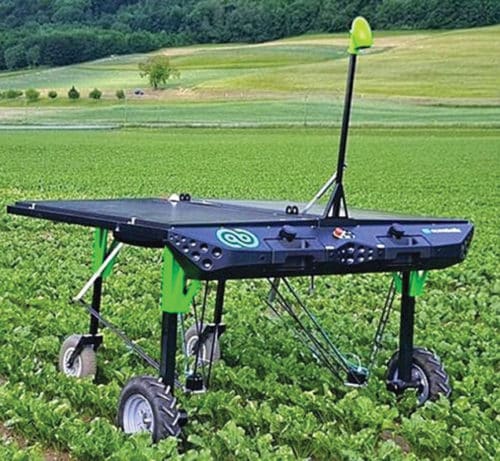Implementing different technologies in agriculture is vital for effectively dealing with growing competition and getting better results while using fewer resources.
Green revolution changed the face of agriculture in the 20th century. While the purpose, that is, growing crops and maintaining livestock remained the same, methodologies changed and that had a significant impact on results. Now, with latest disruptive technologies in Industry 4.0, agriculture is up for a technological revolution. This is the need of the hour owing to increasing demands of the growing population, which have led to more intensive farming practices. Modern agriculture requires a sustainable yet more efficient approach, which is termed as smart farming.
Adoption of the Internet of Things (IoT) for agriculture has been the main push in boosting the volume and quality of items in the industry by enhancing the quality of crops and fertility of the land over the past few years. IoT components comprise mainly smart sensors and devices, connectivity, data processing and analytics, and user interface. Artificial intelligence (AI) and computer vision have made it possible to remotely monitor farms and analyse data.
“Smart farming can support more productive and sustainable farming via an accurate and resource-efficient approach. The potential for smart farming is huge. The farming industry has only just begun to make use of digitalisation,” says Dr Jan Regtmeier, director product management, HARTING IT Software Development.

Evolving methods for all-season farming
Not having accurate knowledge of climatic conditions in an area results in low-yield and low-quality crops. Devastated crops result in higher prices for consumers in the market. For enhancing the yield of crops without worrying about climatic conditions in a place, new ways of farming have come up. Automated agriculture has made indoor agriculture possible, thereby preventing land deterioration and increasing production of reliable food supply.
The concept of vertical farming is being adopted at a rapid pace. Vertical farms cultivate crops and raise cattle inside dedicated or mixed-use skyscrapers, which meet the growing requirements of urbanisation. This way plants can grow without sunlight. As sensitivity of crops to light varies based on wavelength, energy-efficient lighting using LEDs can ensure that light levels are optimised. Green Sense Farms has developed a commercial farm that utilises LED lights that are customised for each crop. Advantages of such a system include efficient crop production irrespective of weather, so that consumers get fresh food throughout the year at low rates.
Smart greenhouse-based farming is one method where such environmental parameters as pressure, humidity, temperature and light levels are monitored and controlled with the help of IoT-based sensors without the need for manual assistance, which increases accuracy.
AgritechMurcia platform consists of numerous agricultural technology firms that work on projects for providing ideal farming solutions. One such project developed as part of this is construction of greenhouses for organic farming.
When connected to a cloud server, the system can be remotely accessed to enable data processing. Many platforms are available for translation of data into actionable insights for farmers. Sensors can control actuators through Wi-Fi signals to perform different tasks, including regulating the heater, change light levels and more. In addition to decreasing costs, to make it eco-friendly, solar-powered IoT sensors can be used. Emails or SMS alerts can be sent to the user regarding the current state of variables.
Ag-tech tools and techniques for crop cultivation
Precision farming is the most popular end-to-end application of the IoT in the agricultural sector. Companies like Arable, Gamaya and CropX are some of the key names in this field. Gamaya, for example, focuses on large-scale monitoring and diagnostics through hyperspectral imaging and Big Data. The business has smart solutions for soybean and sugarcane cultivation.
Using precision farming, instead of applying inputs like water, fertilisers and pesticides uniformly across the field, farmers target a specific area or even a single plant and apply inputs that optimise crop production.
Real-time weather data collected through weather stations or by different sensors includes information about various parameters like humidity, rainfall, temperature and more. Alerts are sent if weather conditions are unsuitable. US-based aWhere is one such company that gives smart climate insights using machine learning algorithms to farmers, crop consultants and retailers.
Soil parameters measured using sensors are texture, salinity levels, nutrient status, organic content, etc. Trace Genomics has developed an analytics engine to map the living soil and protect it.
It allows farmers to make better decisions about the crops that can be grown, their harvesting and future-planning for that land. By optimising planting of seeds, better seed-spacing and depth-control are guaranteed. Based on the amount of light reflected back to the optical crop sensors, sensing the correct amount of fertilisers needed by the crops is done in real time to prevent runoff of excess chemicals into nearby water bodies.
Variable-rate applications (VRA) are centred on understanding the relative productivity of different areas based on data obtained from sensors. Automated equipment and machinery can then be used to optimally apply herbicides, fertilisers and the like at variable rates and prevent overlapping. Maps and GPS ensure that machinery navigation and positioning are accurate. Nano-materials-based pesticides and insecticides further improve precision.
Drones, both ground and aerial, are being used for crop planting and monitoring, field analysis, etc these days. With thermal or multispectral sensors, irrigation patterns essential for various fields can be identified. Irrigation can be controlled remotely through a PC or mobile. Benefits include integrated Geographic Information System (GIS) mapping as well as saving time and possibly increased yields. Several companies like DroneSeed, Agribotix, Skycision and HiveUAV have been providing drones for agricultural applications. Using drones, farmers can remotely manage crop operations without being a drone expert.
Utilising optical sensors, drones and satellite imagery, it is also possible to assess the health of various crops. Using mobiles and tablets, any pest population or weed activity on the farm can be checked, and then effectiveness of pest- and disease-control procedures can be evaluated. One of the most common methods is Normalized Difference Vegetation Index (NDVI). It uses wavelengths of infrared (IR) and visible light to detect crop variability and different crop stages.
Many companies are also building farm robots. These are commonly used for automation of agricultural processes like planting, irrigation, weed management, harvesting crops, fruit picking, ploughing, soil maintenance and so on. For instance, Ecorobotix and Blue River have come up with robots that can identify weeds in real time using cameras and communicate the information to another piece of machinery through telematics to decide on the appropriate action that needs to be taken for dealing with them.

Once crops are harvested, impure crop shipments can be avoided through electronic security tagging. This enables transparency to a great extent. Once consumers are aware of the entire supply chain, it is easier to prevent food-borne diseases.
Livestock monitoring
The IoT can also be used to gather information about the location and health of cattle. Installing cameras around barns and pastures enables remote monitoring of animals from anywhere. Collars with radio frequency identification (RFID), which can be low, high or ultra-high frequency, GPS and biometrics can automatically identify and provide important data about the livestock, such as birth date, mother’s and father’s ID numbers, offspring, veterinarian records and so on in real time.
Apps like Connecterra IDA are used for getting updates about the animals. This way each animal gets special attention and a database of their history can be maintained. This also assists in easily locating and separating sick animals from the rest to prevent spreading of disease. For example, CowManager by Agis Automatisering is a cattle-tracking sensor and software solution.
For preventing animals from going to unwanted places, conventionally low-voltage shocks and sound stimuli have been used. Several organisations are building harmless and cost-effective alternative solutions for this. Vence, for instance, has created a virtual fencing wearable for cattle.
Ultrasounds can check the quality of meat that can be obtained from an animal even before reaching the market. Research is ongoing to create different kinds of foods (meat and drinks) by manipulating genes in the future.
Software and platforms for data management
The IoT sensors collect a huge amount of data that cannot be stored on a conventional database system. Cloud-based data storage and end-to-end IoT platforms ensure that data related to weather, livestock and crop get analysed using tools for predictive analytics.
Many apps available in the market can be used for real-time data collection by field teams and to send updates. Software platforms like Cropio pile data from different hardware devices used in precision agriculture on a central platform for processing and analysing, which is crucial for making effective choices for managing farm operations. Data platforms provide aggregated data to farmers at a single location as a resource. Task management tools can easily create budgets and operation strategies for production, and compare yields against standard values.
Challenges
Many farmers are reluctant to change because they cannot afford the expensive tools and machinery required, while others are not aware of the benefits. In cases where land is not owned by the farmers themselves, there are lower chances of investment. Besides, several farmers in developing and underdeveloped countries lack the needed educational qualifications. In developed countries, the average age of farmers is quite high. This
impacts their decision-making and capability of learning new technologies.
In using all these technologies, an Internet connection is a must for strong network communication. In places with poor connectivity, farmers have to struggle to make them work, which impacts their motivation.
Implementing different technologies in agriculture is vital for effectively dealing with growing competition and getting better results while using fewer resources. Crop-harvesting robots, like those by Harvest CROO Robotics, can make up for the lack of enough workforce in developed nations. For staying in business, adoption of these measures is not optional but mandatory. Before making any decision on long-term investments, farmers should consult experts and fellow farmers regarding potential benefits. It is not only necessary for owners but also for employees to learn to work with these technologies.






